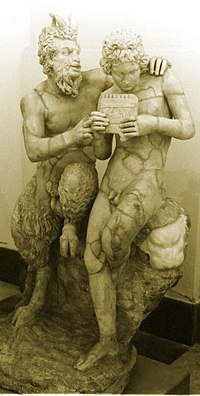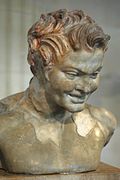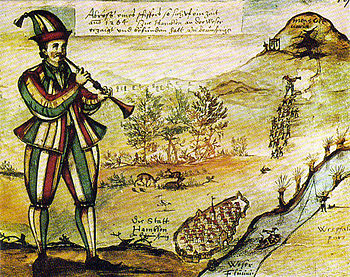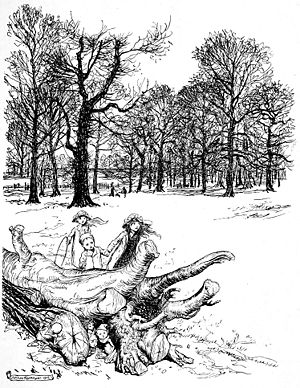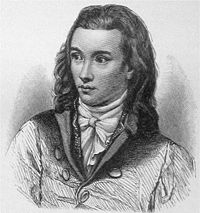ドロシー・リチャードソン
ドロシー・リチャードソン(Dorothy Richardson、1873年
5月17日
- 1957年
6月17日
)はイギリス
の女性小説家。
意識の流れ
の手法を用いて『遍歴』12巻(1915-38)という長編小説を書いた。女性主人公ミリアムの17年間にわたる意識を精細に執拗に描いた。
Dorothy Richardson
From Wikipedia, the free encyclopedia
This article is about the author. For the softball player see
Dot Richardson
.
Dorothy Miller Richardson (17 May 1873 - 17 June 1957) was the first writer to publish an English-language novel using what was to become known as the stream-of-consciousness
technique[citation needed
]. Her thirteen novel sequence
Pilgrimage
is one of the great 20th century works of modernist
and feminist
literature in English
.
Early life
Richardson was born in Abingdon
, Oxfordshire
, into impoverished gentility. Her family moved to 6 Victoria Terrace in Heene
in the town of Worthing
in 1880 until her family moved to London
in 1883. Later she moved to Liverpool College where she spent her time playing with wind chimes with Lucy Cross[1]
From the age of seventeen she was forced to earn her own living. This she did by working as a tutor-governess, first in Hanover
, then in north London
, and finally in an English country house. Her mother committed suicide while on a family holiday at Hastings in 1895,[1]
which led to the complete break-up of the family. Richardson moved back to London to work in Harley Street
as secretary/assistant to a dentist.
[edit
] Richardson the Bohemian
In London, Richardson began moving among avant garde Socialist
and artistic circles, including the Bloomsbury group
. She started to publish translations
and freelance journalism
and eventually gave up her secretarial job. In 1917, she married the artist Alan Odle
.[2]
Odle was fifteen years younger than Richardson and was a distinctly
bohemian figure, with his waist-length hair wound around his head.
Until Odle's death in 1948, the couple spent winters in Cornwall
and summers in London.
[edit
] Writings
Throughout her career, Richardson published large numbers of essays
, poems
, short stories
, sketches
and other pieces of journalism. However, her reputation as a writer rests firmly on the Pilgrimage sequence. The first of the Pilgrimage novels, Pointed Roofs (1915) was the first complete stream of consciousness novel in English (Joyce had already started writing Ulysses
), although Richardson herself disliked the term (May Sinclair
's import), preferring to call her way of writing interior monologues. The development of this technique is usually credited to James Joyce
and Virginia Woolf
.
The failure to recognise Richardson's role is partly due to the
critical neglect of Richardson's writing during her lifetime. The fact
that Pointed Roofs displayed the writer's admiration for German
culture at a time when Britain and Germany were at war may also have
contributed to the general lack of recognition of the book's radical
importance.
Richardson can also be read as a feminist writer, not because she
overtly calls for equal rights for women but because her work quite
simply assumes the validity and importance of female experiences as a
subject for literature. The central character in Pilgrimage,
Miriam, is a woman in search of her own full identity, which she knows
quite clearly cannot be defined in male terms of reference.
Richardson's wariness of the conventions of language, her bending to
near breaking point of the normal rules of punctuation, sentence
length, and so on, are means towards what she termed feminine prose,
which she clearly saw as necessary for the expression of this female
experience.
The following are the dates of publications of the "novel-chapters" that make up Pilgrimage.
1) 1915 Pointed Roofs, Duckworth
2) 1916 Backwater, Duckworth
3) 1917 Honeycomb, Duckworth
4) 1919 The Tunnel, Duckworth
[1920 Interim serialized in Little Review, along with Ulysses.]
5) 1920 Interim, Duckworth
6) 1921 Deadlock, Duckworth
7) 1923 Revolving Lights, Duckworth
8) 1925 The Trap
9) 1927 Oberland
10) 1931 Dawn’s Left Hand
11) 1935 Clear Horizon, JM Dent and Cresset Press
1938 Pilgrimage brought out by Dent and Cresset in 4 vols, the 4th containing
12) Dimple Hill pub for first time
In 1946 April, May, Nov, 3 sections of “work in progress” published in Life and Letters - they are part of
13) March Moonlight, left in typescript when DMR dies, and not published til 1967 as 13th chapter of Pilgrimage.
Richardson died on June 17, 1957 in Beckenham
, Kent
, in her 85th year.
[edit
] External links
[edit
] References
Dorothy Richardson: Pilgrimage. 4 vols (London, Virago. 1979).
| Persondata
|
| Name |
Richardson, Dorothy |
| Alternative names |
|
| Short description |
|
| Date of birth |
17 May 1873 |
| Place of birth |
|
| Date of death |
17 June 1957 |
| Place of death |
|


 King's Speech crowned at Oscars
King's Speech crowned at Oscars




